[Microprose, Atari 8-bits]
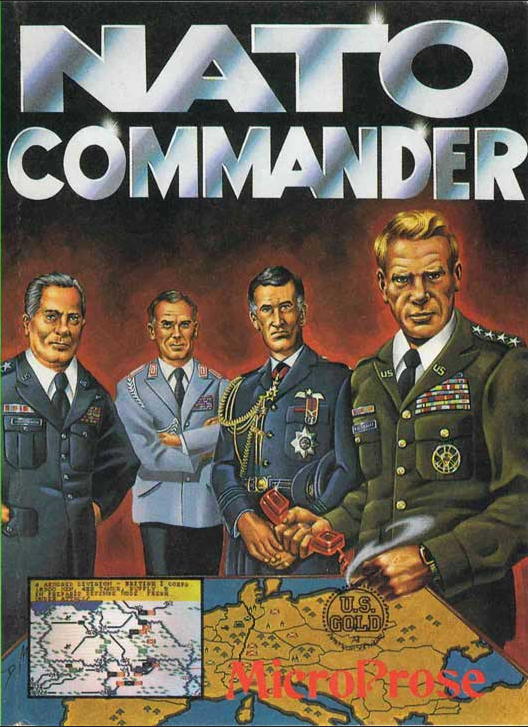
“Technically, it should be “NATO and French Army Commander”
NATO Commander, released in November 1983 marks the debut of Sid Meier (of Civilization fame) in wargaming, and is innovative enough I cherry-picked it among the remaining 1983 games to be my game #100. The game portrays a classic “Cold War-gone-hot” scenario in Western Europe, starting on May 1st, 1989, in real-time with pause. In the final scenario, which I will be playing, the player is tasked with preventing the Warsaw Pact from overrunning Germany and crossing the Rhine.
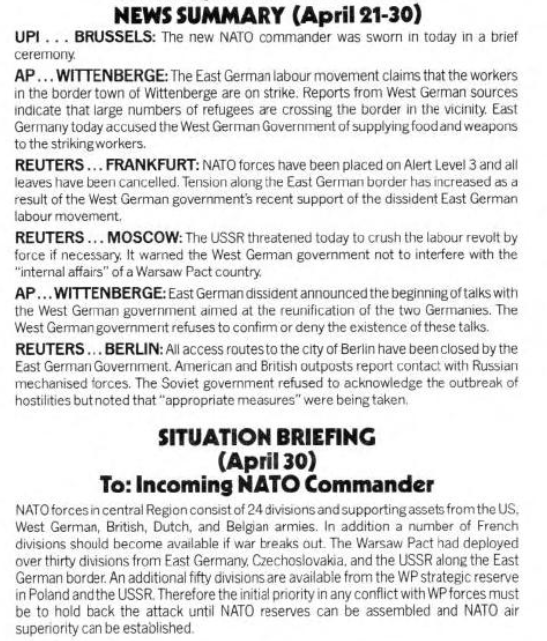
I will take command of the forces of West Germany and the UK (both represented in black), France and the USA (both in blue), and Belgium and the Netherlands (both in green) to repel the Soviets and their stooges. My arsenal will encompass all available assets in the theatre : divisions (mechanized and armoured), brigades (mechanized, armoured, reconnaissance, and militia), SAM batteries, air wings, helicopters, and even American and French nuclear weapons.
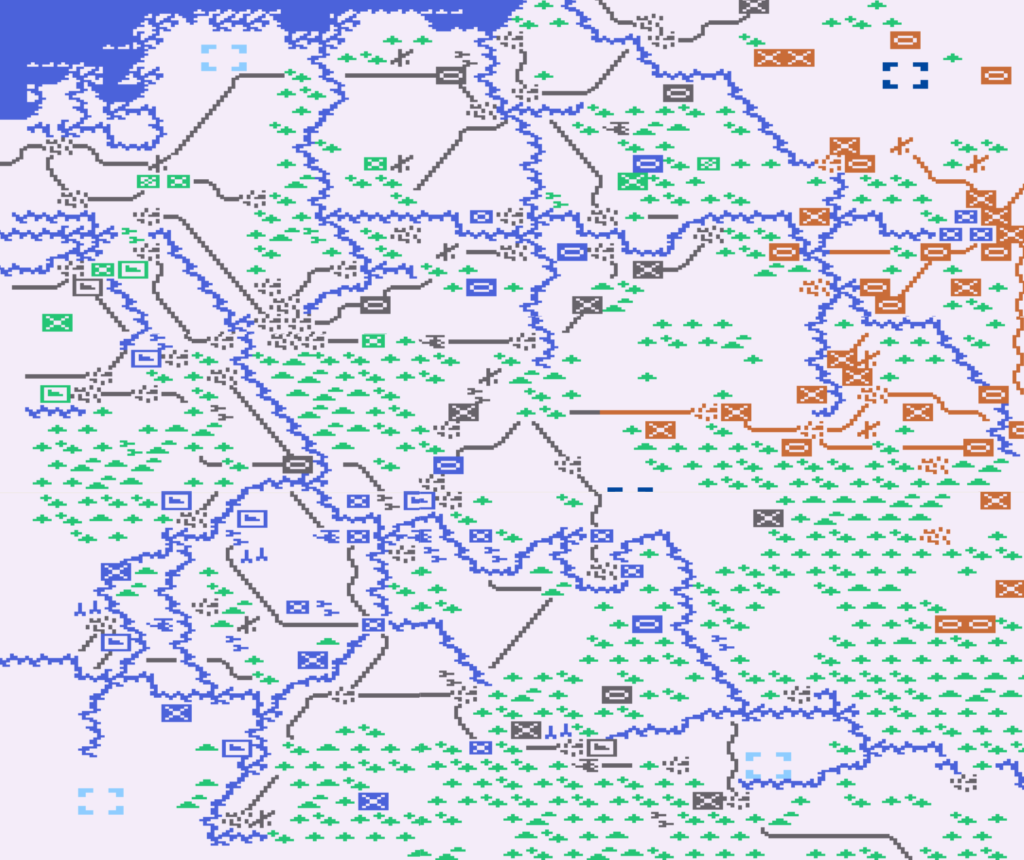

My official orders are to keep as many German cities as possible free from communism. However, my REAL objective is to inflict as much damage as possible while minimizing my own losses. The Soviets will quit if they suffer significantly higher troop losses than I do, not when they fail for the seventh time to capture Bielefeld or whatever other German city that actually exists.
The Warsaw Pact will be receiving a constant stream of reinforcements, while I will only get a trickle of new units (mainly French and American). Therefore, I need to reorganize and utilize the terrain to my advantage as much as possible. The most defensible terrain types are rivers and hills. Hills are scarce, but rivers are plentiful, so rivers will be my primary defensive terrain, though I also need to garrison some towns because the Germans put them on roads, and those roads allow the Soviets to move fast.
Support assets like helicopters or AA batteries are immobile. One helicopter squadron is situated in the forest between Hamburg and Berlin, necessitating its defense, but elsewhere, I will abandon Eastern Western Germany, which is likely to become Western Eastern Germany for a few days at least.

At the end of each day, I receive a progress report. I have managed to avoid contact, so the only combat has been between the diminutive Berlin garrison and the entire Warsaw Pact. The garrison has outperformed itself, but it is poised to be annihilated the following day.
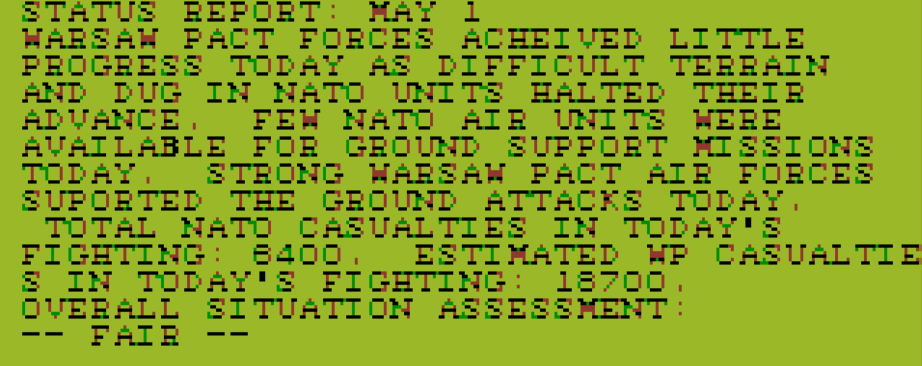
By May 3rd, I have constructed a robust defensive line in the centre, but in the north, a retreating German division is engaged on the river just before it could fully transition from “tactical mode” to “prepared defence.” Further south, the first Soviet armoured division encounters my firmly entrenched NATO forces on the opposite river bank, which I trust will hold firm.

The situation is serious enough that the French agree to integrate into the NATO command structure – a purely cosmetic event triggered after the first losses. I have been controlling the French units since the beginning of the campaign.

And indeed, by the 5th of May, there are combat all along the front. Wherever I was able to fortify on the bank of a river, I am totally confident they will not pass any time soon. Alas, that’s not the case everywhere :
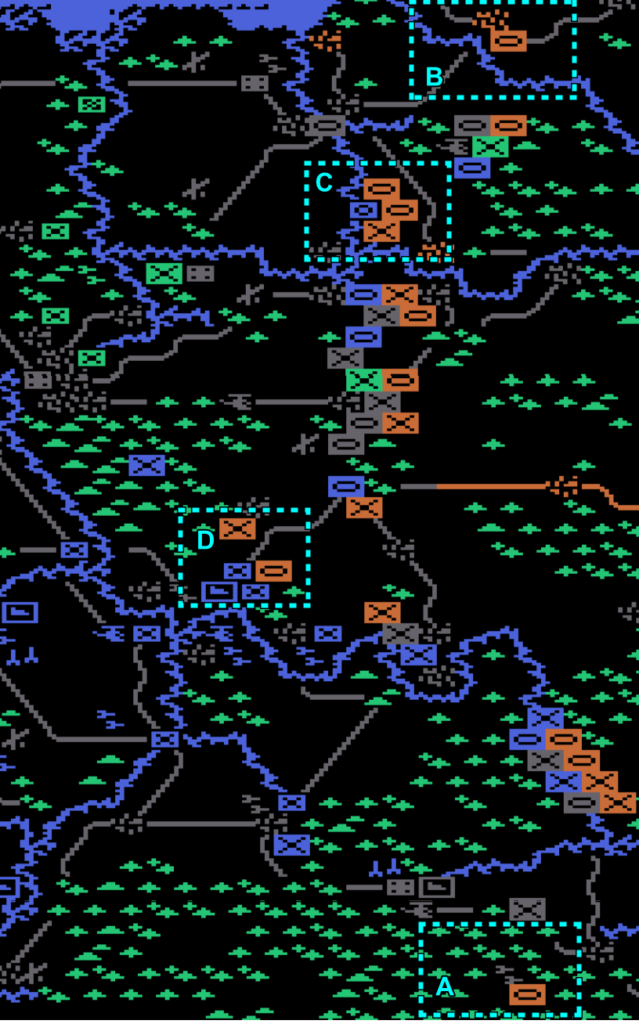
In the South (A), a Czech tank division has bypassed my mechanized division guarding the road and is now assaulting my AA defenses. These AA defenses are crucial for whittling down the Warsaw Pact air force, which is currently providing close air support (CAS) and giving a combat bonus to all the Warsaw Pact ground units. My own air force is fully committed to air superiority, aiming to destroy the communist air force so I can later safely launch my own CAS missions. AA defences accelerate this process, so I would have preferred to lose them a bit later.

At the opposite end, in B, the Soviets have destroyed my poorly entrenched division and are on the verge of crossing. Another strong Soviet force is also crossing more to the South in C, with only a hapless tank brigade slowing them down. All I have to counter this is one British tank division (north of C), and a handful of reinforcements coming from the West.
The most alarming development is in D. The Warsaw Pact has surged through a massive gap in my line. All that stands between them and one of my air wings are two US infantry brigades, while the Rhine is guarded by a French mechanized division (currently in the forest) and a US infantry brigade securing the bridge. Not ideal.
In an attempt to thwart this penetration, I decide to counter-attack with all available helicopters (helicopters can strike any location on the map from their current position but cannot move). This isn’t ideal – helicopters are fragile, especially when Soviet planes are still around, but the situation calls for it. I instruct my helicopters to deploy chemical weapons, which costs me a few victory points but is devastating against infantry. The Soviets have not been hesitant to use these either.
Combats are particularly brutal, both where the Soviets and their allies have crashed against my line of defence and where I have to counter-attack. The end-of-day report reflects this :
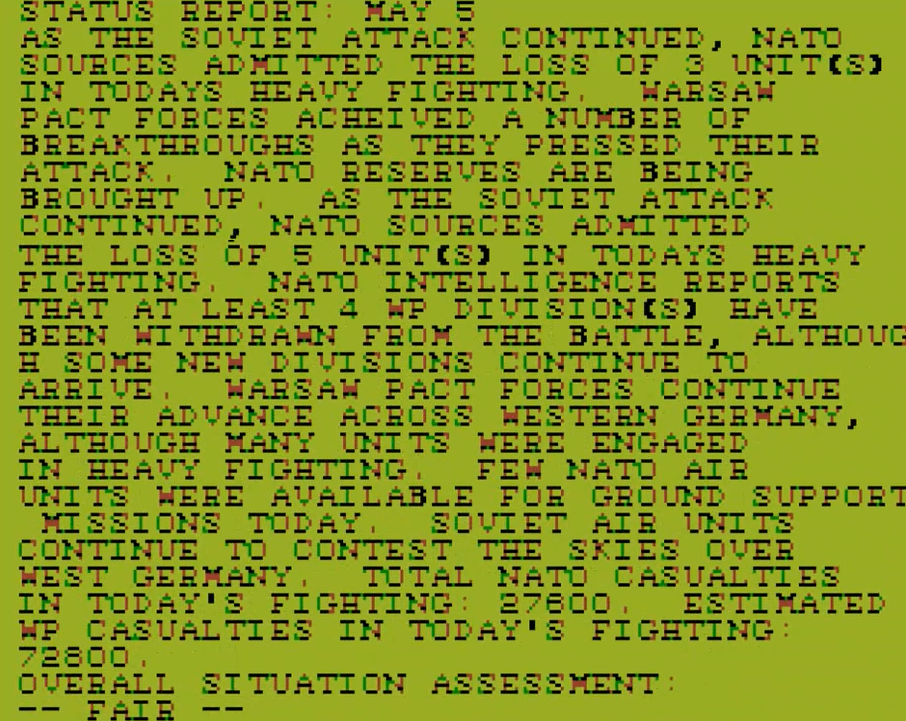
The good news is that the Soviets have incurred unsustainable losses. If I can maintain a 1:3 casualty ratio against them, I should prevail. However, I have lost more units than the Communists, resulting in negative Victory Points (VPs) for now.

My very negative VP triggers a cosmetic event that should have been unrelated : the defeat of Finland.

May 6th is a mixed bag. Despite heavy helicopter losses, I manage to eradicate any units that penetrated my center, though some VDV (Soviet paratroopers) are loose in the general area. In the north, I eliminated a Soviet division attempting to follow the river south. However, my centre is being outflanked, and I don’t control anything in the south where Warsaw Pact units are destroying all my support assets.
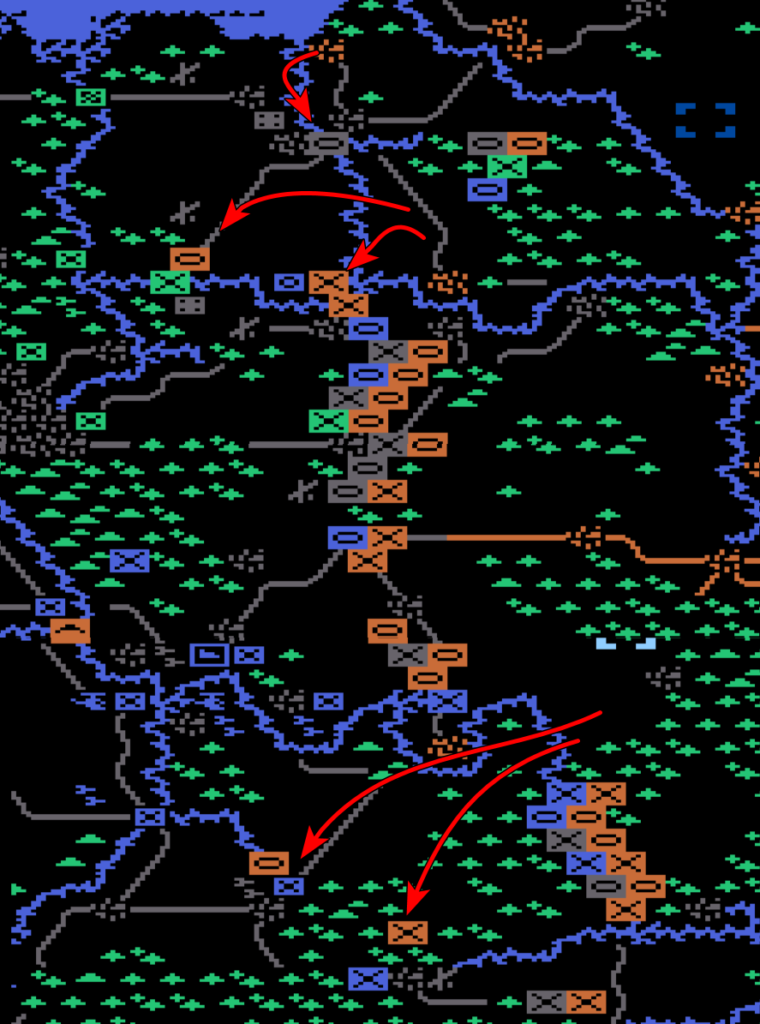
At least, I am still inflicting disproportionate losses on the Warsaw Pact, putting me in the green in “combat points”.

Over the next three days, the situation somewhat improves. I manage to wipe out the remainder of the Warsaw Pact air force, allowing nearly all of my air wings to switch to CAS. I track and destroy the remaining VDVs, leaving only a depleted tank division in my central area – I can’t reach it because it is between fixed units that block my movements. In the north, the units that tried to flank my centers are halted by the first well-entrenched unit they encounter.
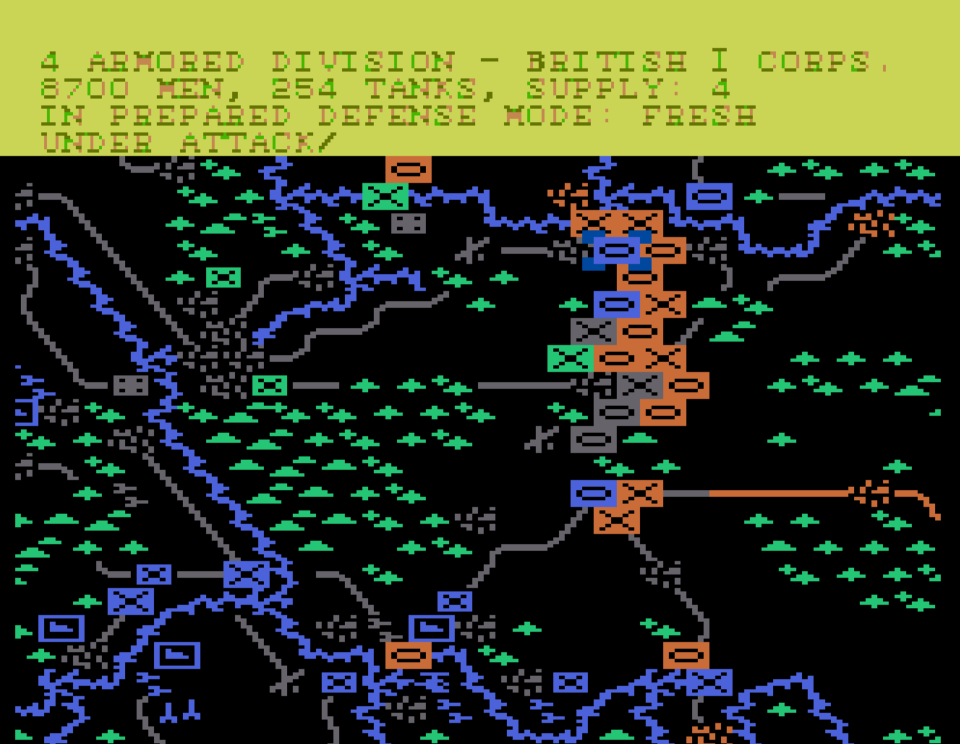
This leaves the South, where the situation is now stable by virtue of not having any support assets to defend anymore.

In terms of casualty ratios and Combat Points, I am still faring well, and reinforcements arrive daily (1-2 new divisions each day). Perhaps victory is within reach ?

The Soviet commanders concur and take drastic action on the 10th of May, at exactly 22:50 :

Tactical nukes ! The Soviets took the gloves off. These don’t obliterate units outright but weaken them enough to break more easily.
I immediately request and receive authorization to use my own nukes, targeting a few at those Red units that made it to my rear areas. I don’t use as many as I could – each nuke costs me a lot of political points.
Meanwhile, the Soviets, seemingly unconstrained or simply indifferent, continue to rain nukes on my central defensive line over the following days. By May 12th, my center falters :

With the northern area of the map free of enemy units and a noticeable reduction in Warsaw Pact reinforcements, I allocate my own reinforcements to defend the last major urban area I control (Düsseldorf?) and critical river passages. I manage to fortify the main city just in time to face off against three armoured divisions, while my river-defending units engage enemy forces. However, I simply don’t have enough units to defend everywhere, and some Soviet units manage to cross the river. These I must track and attack, but only after an initial tactical strike. By May 15th, I am still holding Western-Western Germany:

I maintain air superiority, and since I’m primarily defending, losses are consistently higher on the Soviet side, causing them political turmoil :

I manage to hold my ground until the 17th, hitting 1200 Combat Points and 300 Victory Points, triggering additional events :

Unfortunately, the situation deteriorates shortly after. I stop receiving reinforcements, and my available forces dwindle. On the 19th, my northern defense collapses :

The Soviet forces ravage my rear before exiting the map to the west. It seems to be the end…
.. or is it ? Even though I lose the few remaining combats on the map, my Combat Points begin to rise again. Possibly, every Warsaw Pact unit that exits West is considered “out of action,” granting me as many points as I would have received for destroying it. Even better, these units are not replaced. On the 25th of May, I become positive again in VPs.
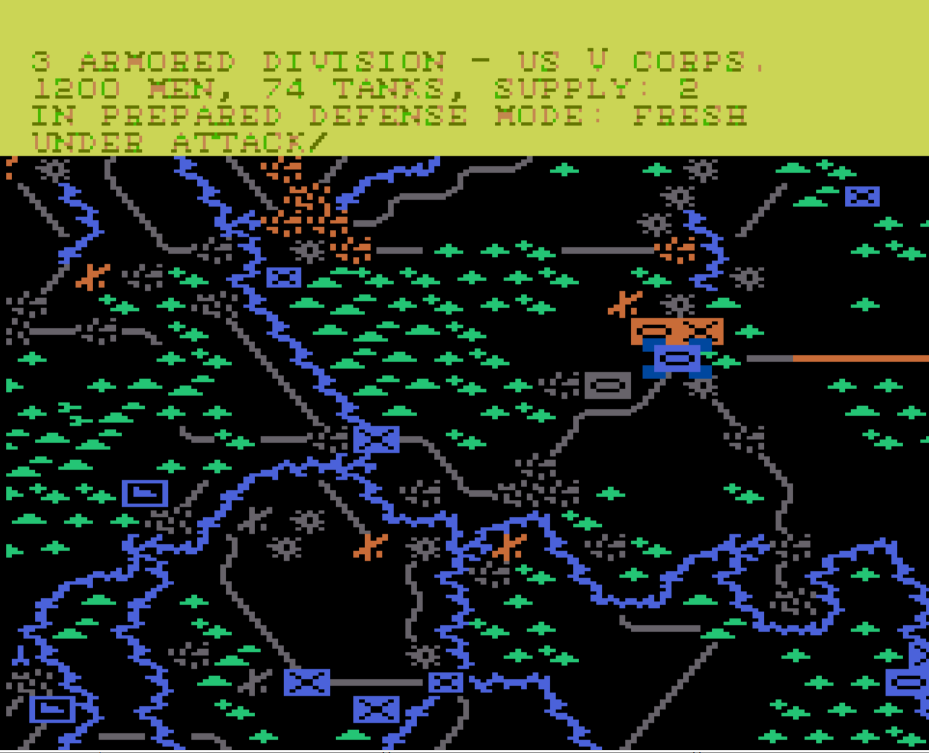
WIth the few units I have left, I start to safely reclaim my cities. By May 30th, I am massively positive in VP.
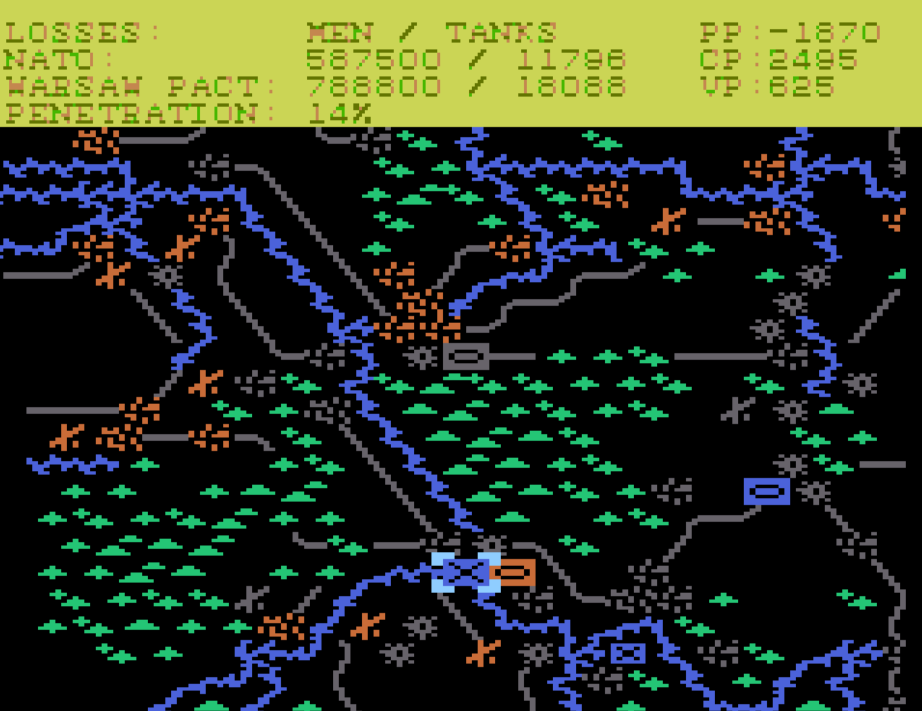
On the 33rd of May, the Yugoslavian government panics and pulls out of the war :

By the 36th of May, there is no more military activity in Germany. Losses are zero on both sides, and I liberate most of West Germany.
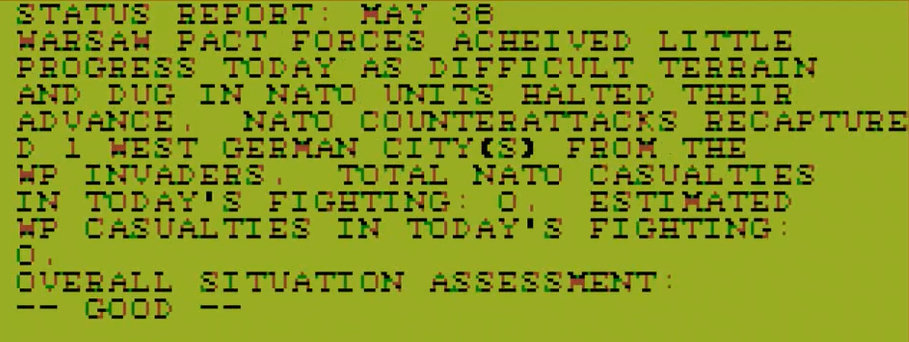
I carefully cross the former border and liberate some Eastern German cities, reaching Berlin on the 46th of May.
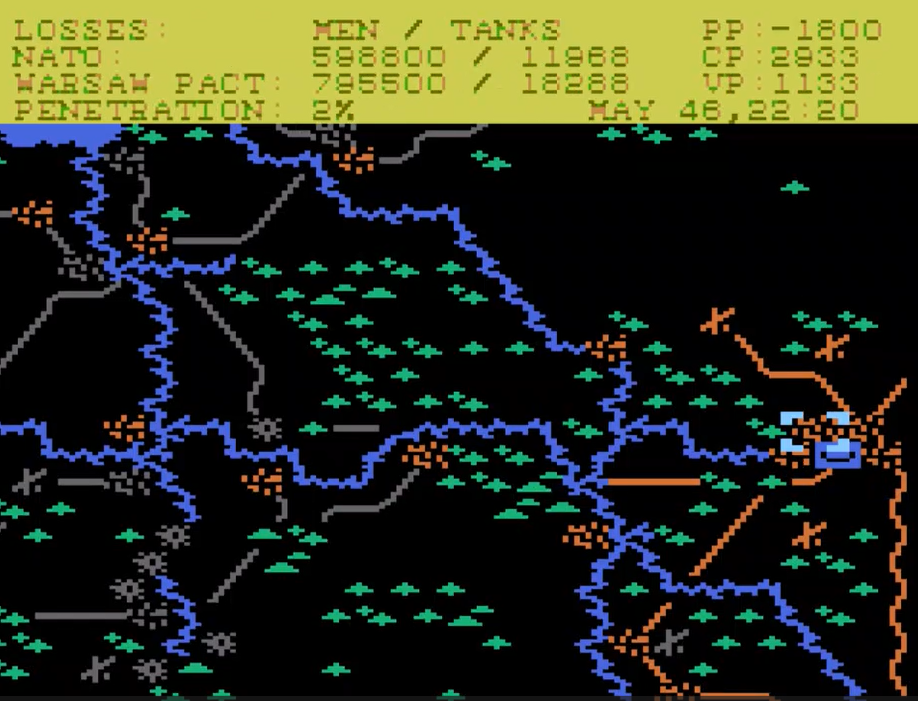
The game ends on the 48th of May with a decisive victory in points.
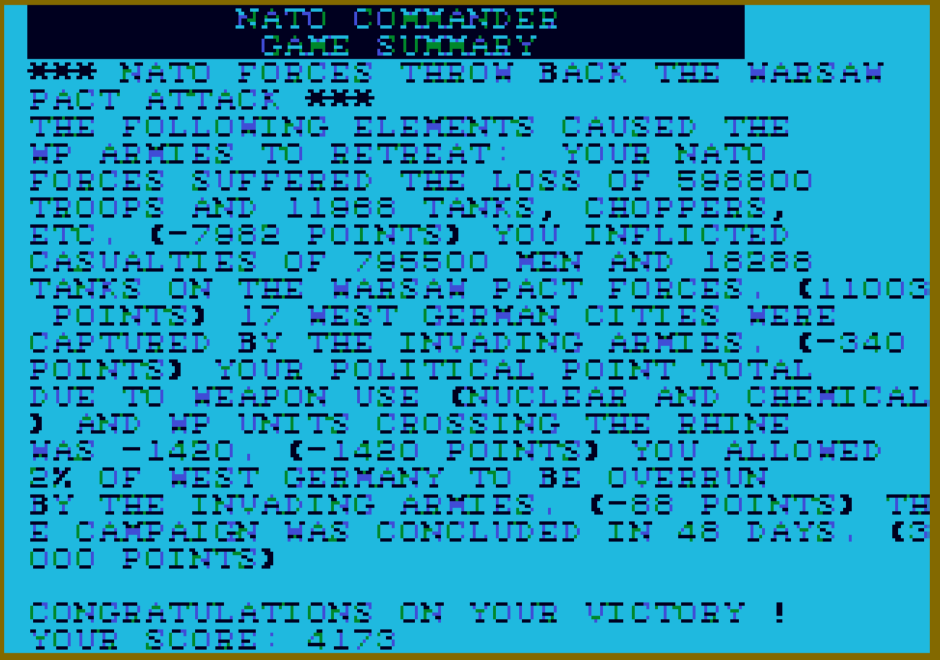
I guess it is a victory for the German government if the Red Army is in France, Belgium and the Netherlands rather than in Germany. They will manage – after all the French already have a socialist President.
Alas, NATO Commander doesn’t handle its endgame well – this is the second time I’ve won a game due to undeserved last-minute Victory Points. From my experience with smaller scenarios, which I have won fairly, it seems that the game is either won very early by inflicting massive losses on the Warsaw Pact, or not at all. The designers certainly never expected their players to hang on until the bitter end – after all the game has save & load and why would anyone not leverage these ?
Reflecting on the game, I think I made two early mistakes that cost me a fair victory :
- I should have had a more reactive defence in the south, where there were only a few support assets to protect and a front too wide to cover fully. Numerous Czech units bypassed my defences and destroyed all my support assets without my prepared defence units being able to respond.
- I should not have tried to defend the advanced helicopter squadron in the northern forest. In doing so, I fortified three of my divisions out of position and created a significant gap in my line.
I am not going to give the game another go. I technically won after all, and more importantly, it is not really fun to play – this I will make clear in the Rating & Review.